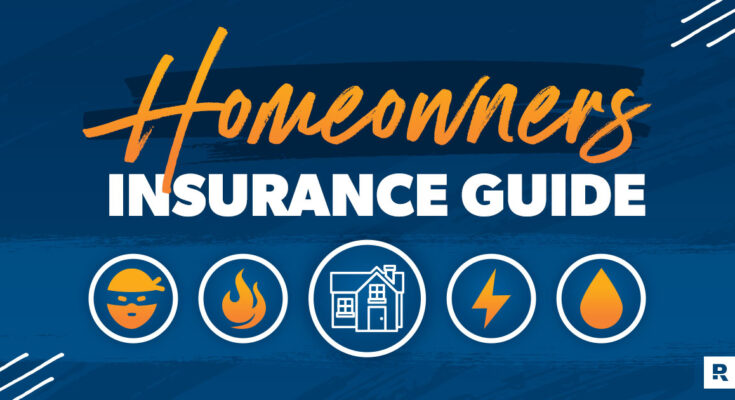Owning a home is a significant milestone, but it also comes with its share of responsibilities and risks. One crucial aspect of responsible homeownership is securing the right insurance coverage to protect your investment and belongings. Homeowners insurance is designed to provide financial protection in the event of unforeseen disasters, accidents, or losses. In this comprehensive guide, we’ll explore the basics of homeowners insurance, the different types of coverage available, what isn’t covered, how rates are determined, and tips on comparing insurance companies.
What a Homeowner’s Policy Provides
A homeowners insurance policy is a contract between you and an insurance company that protects your home and personal property from various risks. The primary components of a standard homeowners insurance policy typically include:
1. Dwelling Coverage:
Dwelling coverage is the core component of a homeowners insurance policy. It provides protection for the structure of your home, including the walls, roof, floors, ceilings, built-in appliances, and other structural components. In the event of covered perils like fire, windstorms, or vandalism, dwelling coverage helps repair or rebuild your home.
2. Personal Property Coverage:
This aspect of homeowners insurance covers your personal belongings, such as furniture, clothing, electronics, and other valuables. If your possessions are damaged or stolen, personal property coverage helps reimburse you for the cost of replacing or repairing them, up to the policy’s limits.
3. Liability Coverage:
Liability coverage is designed to protect you financially in case someone is injured on your property, and you are found legally responsible. It can help cover medical expenses, legal fees, and damages awarded in a lawsuit.
4. Additional Living Expenses (ALE):
If your home becomes uninhabitable due to a covered peril, ALE coverage assists with the additional living expenses you might incur, such as temporary housing, meals, and transportation.
5. Other Structures Coverage:
This part of the policy provides protection for structures on your property that are not attached to the main dwelling, such as a detached garage, shed, or fence.
Different Types of Homeowners Coverage
Homeowners insurance comes in several forms, each offering a different level of coverage. The most common types are:
1. HO-1: Basic Form
HO-1 policies are basic and provide coverage for a limited number of perils. These policies are less common because they offer minimal protection compared to more comprehensive options.
2. HO-2: Broad Form
HO-2 policies cover a broader range of perils than HO-1. They typically include coverage for common risks such as fire, theft, vandalism, and certain natural disasters.
3. HO-3: Special Form
HO-3 is the most common type of homeowners insurance. It provides broad coverage for the dwelling and other structures, with named perils for personal property. This means that the policy explicitly lists the perils it covers, and anything not mentioned is excluded.
4. HO-5: Comprehensive Form
HO-5 policies offer open perils coverage for both the dwelling and personal property. This means that unless a peril is specifically excluded, it is covered. HO-5 policies are more inclusive but may come with a higher premium.
5. HO-6: Condo Insurance
Designed for condo owners, HO-6 policies cover the interior of the unit and personal property. The condominium association’s master policy typically covers the building structure and common areas.
6. HO-8: Older Home Form
HO-8 policies are designed for older homes and provide coverage based on the actual cash value rather than the replacement cost. This means that depreciation is factored into claims payouts.
What Isn’t Covered by Homeowners Insurance?
While homeowners insurance offers robust protection, it’s essential to be aware of its limitations. Certain events and circumstances are typically excluded from coverage, including:
1. Flood Damage:
Homeowners insurance generally does not cover damage caused by floods. For flood protection, a separate flood insurance policy through the National Flood Insurance Program (NFIP) or a private insurer is necessary.
2. Earthquakes:
Similarly, earthquakes are usually not covered under standard homeowners insurance. If you live in an earthquake-prone area, consider purchasing a separate earthquake insurance policy.
3. Routine Maintenance:
Homeowners insurance is not designed to cover the costs of routine maintenance or wear and tear. It’s the responsibility of the homeowner to maintain the property to prevent damage.
4. Home Business Liability:
If you run a business from home, liability coverage for your business activities may not be included in standard homeowners insurance. You may need additional coverage for business-related liability.
5. Certain High-Value Items:
While personal property coverage includes your belongings, high-value items like jewelry, art, or collectibles might have limited coverage. Consider adding a rider or endorsement to cover these items adequately.
How Are Homeowners Insurance Rates Determined?
Several factors influence the cost of homeowners insurance, and insurers use a combination of these factors to determine your premium. Understanding these elements can help you manage your insurance costs effectively:
1. Location:
The location of your home plays a significant role in determining your insurance rates. Factors such as the local crime rate, proximity to a fire station, and the risk of natural disasters in the area can impact premiums.
2. Replacement Cost of Your Home:
The cost to rebuild your home, known as the replacement cost, is a key factor in determining your premium. This includes construction costs, materials, and labor.
3. Home Features and Age:
The age and features of your home, such as the type of roofing, electrical system, and heating, ventilation, and air conditioning (HVAC) system, can affect your insurance rates.
4. Your Claims History:
Insurers consider your claims history when determining rates. If you have a history of frequent claims, you may be perceived as a higher risk, leading to higher premiums.
5. Credit Score:
In many states, insurers use credit scores as a factor in setting homeowners insurance rates. Maintaining a good credit score can help lower your premiums.
6. Deductible Amount:
The deductible is the amount you pay out of pocket before your insurance coverage kicks in. Choosing a higher deductible can lower your premium, but it’s essential to ensure you can afford the out-of-pocket expenses if a claim arises.
How to Compare Home Insurance Companies
Choosing the right homeowners insurance provider is a crucial step in ensuring you have the coverage you need at a reasonable cost. Here are some tips for comparing insurance companies:
1. Research and Reviews:
Start by researching different insurance companies. Look for customer reviews, ratings, and testimonials to get a sense of the company’s reputation and customer satisfaction.
2. Financial Stability:
Check the financial stability of the insurance companies you’re considering. Rating agencies like A.M. Best, Moody’s, and Standard & Poor’s provide insights into the financial health of insurers.
3. Coverage Options:
Evaluate the coverage options offered by each insurance company. Consider your specific needs and choose a company that provides the level of coverage you require.
4. Discounts:
Inquire about available discounts. Many insurers offer discounts for bundling home and auto insurance, having a security system, or maintaining a claims-free history.
5. Customer Service:
Excellent customer service is crucial, especially when you need to file a claim. Look for an insurance company with a reputation for responsive and helpful customer service.
6. Compare Premiums:
While cost shouldn’t be the sole factor in your decision, it’s essential to compare premium quotes from different insurers. Ensure that you’re getting a good balance of coverage and cost.
What Are the Different Types of Homeowners Insurance Policies?
Understanding the different types of homeowners insurance policies is key to choosing the right coverage for your needs. The most common policy types include:
1. Standard Homeowners Insurance:
As discussed earlier, standard homeowners insurance policies, such as HO-3, provide comprehensive coverage for the dwelling, personal property, liability, and additional living expenses.
2. Condo Insurance (HO-6):
Designed for condo owners, HO-6 policies cover the interior of the unit, personal property, and liability. Condo owners typically rely on the condominium association’s master policy for coverage of the building structure.
3. Renters Insurance:
While not homeowners insurance per se, renters insurance (HO-4) is a similar type of coverage for those who rent their homes. It protects personal property, provides liability coverage, and offers additional living expenses in case of covered perils.
4. Mobile Home Insurance:
Mobile home insurance is specifically designed for mobile or manufactured homes. Policies (usually HO-7) cover the dwelling, personal property, liability, and may include coverage for detached structures.
5. Specialized Policies:
For unique situations, there are specialized policies such as vacant home insurance for unoccupied properties, landlord insurance for rental properties, and more. These policies cater to specific needs beyond the scope of standard homeowners insurance.
Conclusion…
In conclusion, homeowners insurance is a critical aspect of responsible homeownership, providing financial protection against unforeseen events and disasters. Understanding the different types of coverage, what’s included and excluded, how rates are determined, and how to compare insurance companies can help you make informed decisions to safeguard your home and belongings. As you embark on your homeowners insurance journey, remember that each policy is unique, so it’s crucial to tailor your coverage to meet your specific needs and circumstances.
FAQs
Homeowners insurance is a form of property insurance that covers losses and damages to an individual’s house and assets in the home. It also provides liability coverage against accidents in the home or on the property. This insurance policy combines various personal insurance protections, which can include losses occurring to one’s home, its contents, loss of use (additional living expenses), or loss of other personal possessions of the homeowner, as well as liability insurance for accidents that may happen at the home.
Most homeowners insurance policies cover damage caused by fire, windstorms, hail, lightning, theft, and vandalism. They generally also cover personal liability for harm to others and their property while they are on your property. However, it’s important to note that not all natural disasters are covered by standard policies. For example, floods and earthquakes often require separate policies.
The amount of coverage you need depends on several factors, including the value of your home and possessions, the potential rebuilding costs if your home were completely destroyed (such as after a fire), and your personal liability to others. It’s advisable to conduct a home inventory and consult with an insurance agent to ensure you’re adequately covered without overpaying for unnecessary coverage.
While homeowners insurance is not legally required, most mortgage lenders require borrowers to have insurance coverage for the full or fair value of a property (usually the purchase price) and will not make a loan or finance a residential real estate transaction without proof of it.
You can save money on homeowners insurance by shopping around for the best rates, bundling your homeowners and auto insurance policies, improving home security, making your home more resistant to disasters (such as by adding storm shutters), maintaining a good credit score, and asking about any discounts for which you may be eligible.
If your claim is denied, review your insurance policy to understand why it was denied and consult with your insurance agent or company to clarify any misunderstandings. If you believe your claim was unjustly denied, you can file an appeal with your insurance company’s claims department. If the issue is not resolved to your satisfaction, you may consider seeking legal advice or filing a complaint with your state’s insurance department.



